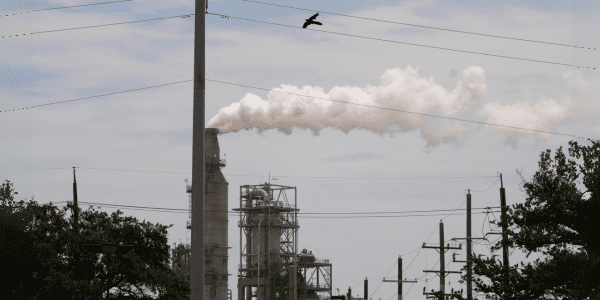
Alexander Spike
Climate Justice Coordinator (Carbon Management)
Houston is well positioned to receive a large amount of the 16.6B federal dollars set aside for Carbon Capture and Storage (CCS), especially the industrial east side centered on the Houston Ship Channel. The channel is saturated with heavy polluting industries like energy, petrochemical, fertilizer, and more. The region is already criss-crossed with pipelines and storage sites. Each of those facilities belches health-harming and climate change-causing air pollution and greenhouse gasses.
The fenceline communities like Pleasantville and Galena Park lining the Ship Channel bear the brunt of this pollution. Cancer rates are far higher in fenceline portside communities than the rest of the region. In Pleasantville backyard polluters like metal recyclers add to the air pollution from the freeways and the Houston Ship Channel. In Galena Park, the air is thick with the smell of chemicals. All this under a regulatory environment often described as reluctant.

Investments in Carbon Capture and Storage Infrastructure
The federal government’s Infrastructure Investments and Jobs Act (IIJA) will put $12.1 billion toward CCS and $4.5 billion toward new carbon pipelines. The Inflation Reduction Act (IRA) raised the 45Q tax credit from $40 to $85 per ton of sequestered carbon dioxide. All earmarked for use by fossil fuel giants.
As a result, CCS is being deployed as a “hail mary” to prolong the lives of some of the most dangerous facilities in the country. CCS has prolonged the life of coal plants, some of the country’s worst air pollution offenders. Let’s look at one case study…
A failed Carbon Capture and Storage experiment on a larger scale
Outside Sugarland sits WA Parish (owned by NRG). Its four coal units and four gas units are responsible for 178 air pollution related deaths every year. Nearby bodies of water are off limits for fishing as a precaution against heavy metal exposure.
WA Parish has proven to be an unreliable power source. The produced power is expensive and the facility has shut down when it mattered most. WA Parish went down during Hurricane Harvey in 2017 and winter storm Uri in 2021, resulting in loss of life. The facility is aging, in desperate need of refurbishment, and is quickly being outmoded by far cheaper solar and wind energy. It is only a matter of time before this plant is closed as an economic liability.

Instead of retiring this dangerous power plant, NRG added Petra Nova, a CCS system. Petra Nova up to this point has failed to capture the level of carbon that it claimed it could, draws large amounts of energy, and requires the carbon it does capture be piped across the state for storage. In 2017, WA Parish received a 1 billion dollar influx of Department of Energy (DOE) cash to build Petra Nova and four methane gas units to compensate for the sizable power draw of Petra Nova. Worst yet, the Petra Nova does not capture carbon to store it permanently underground, but to frack it for more fossil fuels using a process called Enhanced Oil Recovery (EOR).
Not even NRG wants to operate Petra Nova. When the price of a barrel of oil collapsed during the COVID-19 pandemic, Petra Nova shut down entirely. This left the 3.65-gigawatt power plant to operate without any form of carbon pollution control. Three years post-pandemic, after the Petra Nova project was sold to a new firm, Petra Nova had been reactivated. This suggests that WA Parish will likely stay open for the foreseeable future, despite the objective economic conditions discouraging the further use of coal, its health impacts on communities, and its shoddy operational record.
A Prescription for Real Decarbonization
We need to use every tool in the toolbelt to slow climate change, but we cannot lose sight of why we fight. Countries and companies have set ambitious carbon reduction goals to protect themselves and the world’s most vulnerable from incoming climate chaos. It is industrial fenceline communities, like those along the Houston Ship Channel, which will bear the brunt of climate impacts. Addressing climate change requires a comprehensive carbon reduction approach that includes large-scale systemic changes:
- Infrastructure upgrades: Improving the efficiency of buildings and the build-out of electrified rapid mass transit can lead to significant energy savings as well as personal savings by reducing reliance on cars. Fewer cars also means fewer tailpipe emissions including carbon.
- Transition from fossil fuels: The extraction of and dependence on fossil fuels like coal, oil, and gas should be minimized if not eliminated entirely in favor of renewal options like solar, wind, and water. Capping fossil fuel facilities with more technology, like CCS, will not reduce their carbon footprints now or ever.
- Preserve and expand wild green: Containing urban sprawl can encourage smarter land use and spare carbon-storing forest, grassland and wetland areas from destruction. Green spaces, parks, and forests have the positive co-benefit of improving quality of life, protecting us from heat, and encouraging biodiversity.
Lastly, it is crucial to ensure that these solutions are implemented in a way that does not disproportionately impact vulnerable communities in order to preserve the status quo of polluting fossil fuels. Therefore, any climate solution must be equitable and just, must center the voices of impacted communities, and must ensure that no community is left behind in the transition to a sustainable future.
Check out some of our other Carbon Capture information and content:
- Perspectives on Carbon Capture Technology in Houston: A Qualitative Assessment and a Path Forward|Perspectivas sobre la tecnología de capture de carbono en Houston: Evaluación cualitativa y possible camino hacia el futuro
- Close Parish Coal: How the Dirtiest Coal Plant in Texas Harms Public Health and the Environment; and the Alternatives for Fort Bend|Cierre de la planta de carbón de Parish: Los perjuicios que la central de carbón más sucia de Texas causa en la salud pública y el medio ambiente y las alternativas para Fort Bend
- Summary Sheet: What Houstonians Need to Know About Carbon Capture | Ficha resumen: Lo que los residentes de Houston deben saber sobre la captura de carbono
- Statement by Environmental Justice Organizations on the National Symposium Climate Justice and Carbon Management

